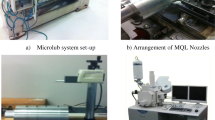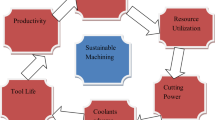Abstract
In order to achieve a more productive and environmentally friendly manufacturing of aerospace propulsion components, minimal quantity lubrication (MQL) can potentially replace the traditionally used flood cooling in different machining operations. These components are manufactured of difficult to machine alloys, which show great hardness even at elevated temperatures. Waspaloy is one of the more demanding super alloys to machine and serve as reference material in this investigation. In this paper, a turning operation is used to investigate the influence of MQL parameters such as oil type together with cutting data on cutting forces and tool wear. As a reference flood and air cooling was used. Two different type of oils were investigated, ester vs. fatty alcohol. The aerosol was directed towards the tool by two different nozzles. Responses that were measured include particle size, aerosol generation capability, cutting forces and tool wear. The experiments were conducted as a D-optimal design of experiments and evaluated by a regression analysis. No evidence of any lubrication effect can be seen. The most plausible explanation of the effects seen is the effects of cooling and heat transfer.
Access this chapter
Tax calculation will be finalised at checkout
Purchases are for personal use only
Preview
Unable to display preview. Download preview PDF.
Similar content being viewed by others
7 References
Autret R., Liang S. Y., 2003, Minimum quantity lubrication in finish hard turning, http://hardingeus.com/usr/pdf/hardturn/LIANG3.PDF
Attanasio A. et al, 2006, Minimal quantity lubrication in turning: Effect on tool wear, Tribology in Manufacturing Processes, vol. 260, n3 p. 333–338.
Rahman M. et al.,2002, Experimental evaluation on the effect of minimal quantities of lubricant in milling, International Journal of Machine Tools and Manufacture, v 43, n11 p 1093–1106.
Klocke F., Eisenblätter G., 1997, Dry Cutting, Annals of the CIRP, 46/2:519–526.
MODDE version 8, 2006, User guide and tutorial, Unimetrics Inc. Kinnelon NJ, USA.
Dahlman P., Kaminski J., 1999, Aspects on High-Pressure Jet-Assisted Turning, Proceedings of the 10 th American Water Jet Conference.
Author information
Authors and Affiliations
Editor information
Editors and Affiliations
Rights and permissions
Copyright information
© 2007 Springer-Verlag London Limited
About this paper
Cite this paper
Beno, T., Isaksson, M., Pejryd, L. (2007). Investigation of Minimal Quantity Lubrication in Turning of Waspaloy. In: Takata, S., Umeda, Y. (eds) Advances in Life Cycle Engineering for Sustainable Manufacturing Businesses. Springer, London. https://doi.org/10.1007/978-1-84628-935-4_53
Download citation
DOI: https://doi.org/10.1007/978-1-84628-935-4_53
Publisher Name: Springer, London
Print ISBN: 978-1-84628-934-7
Online ISBN: 978-1-84628-935-4
eBook Packages: EngineeringEngineering (R0)




